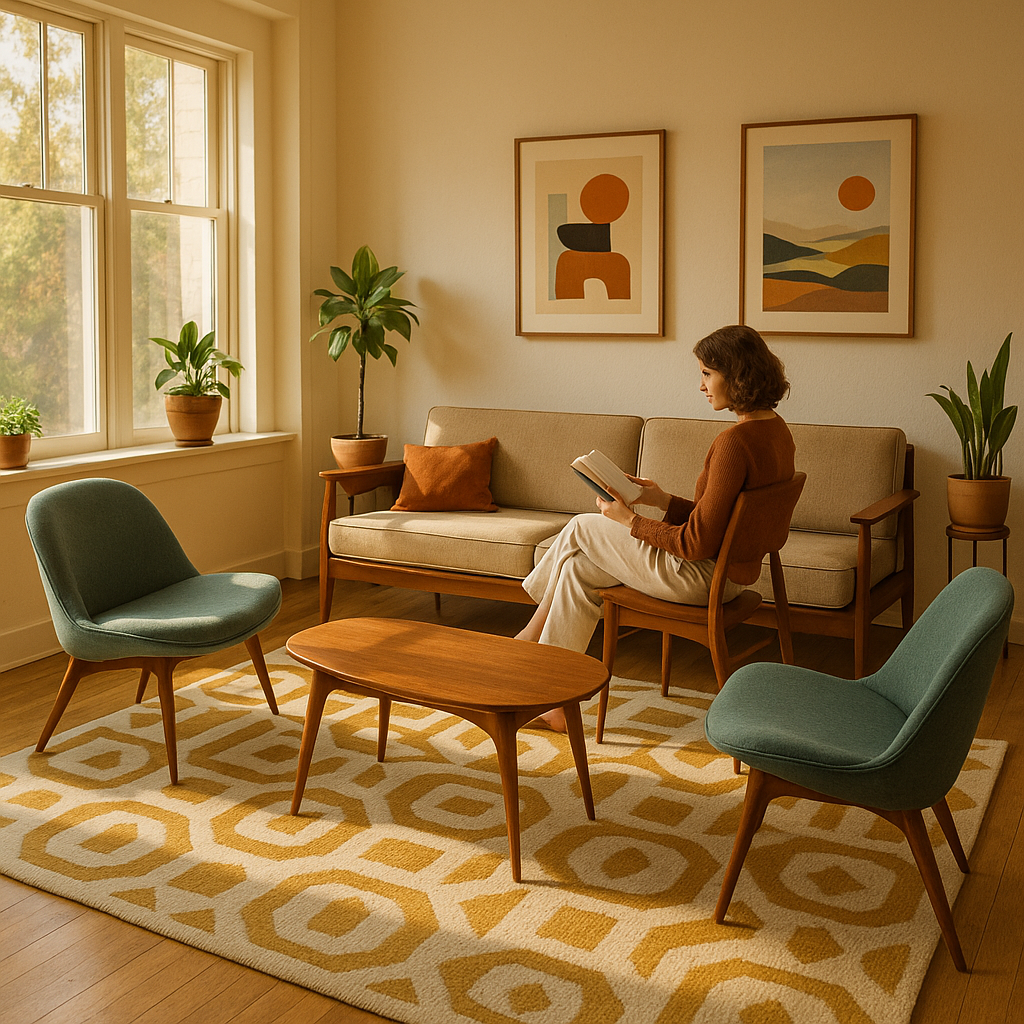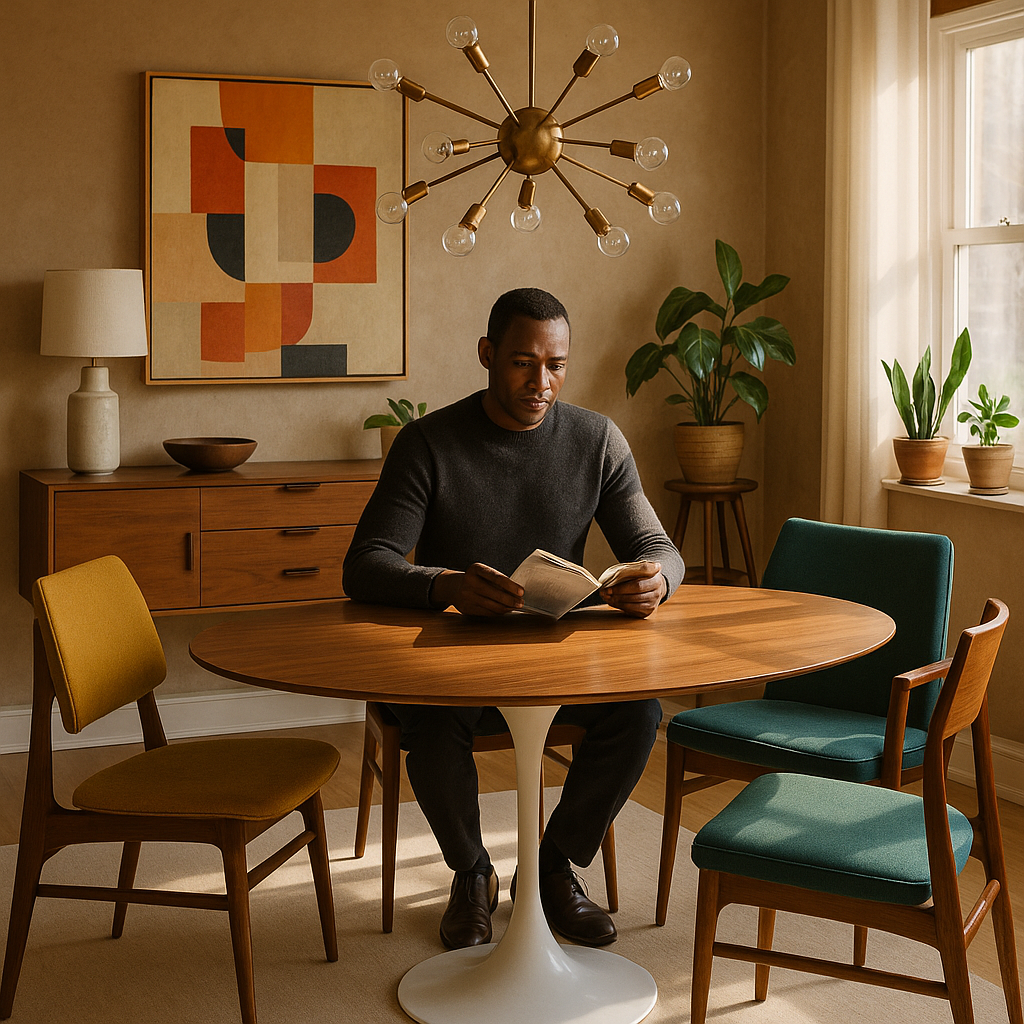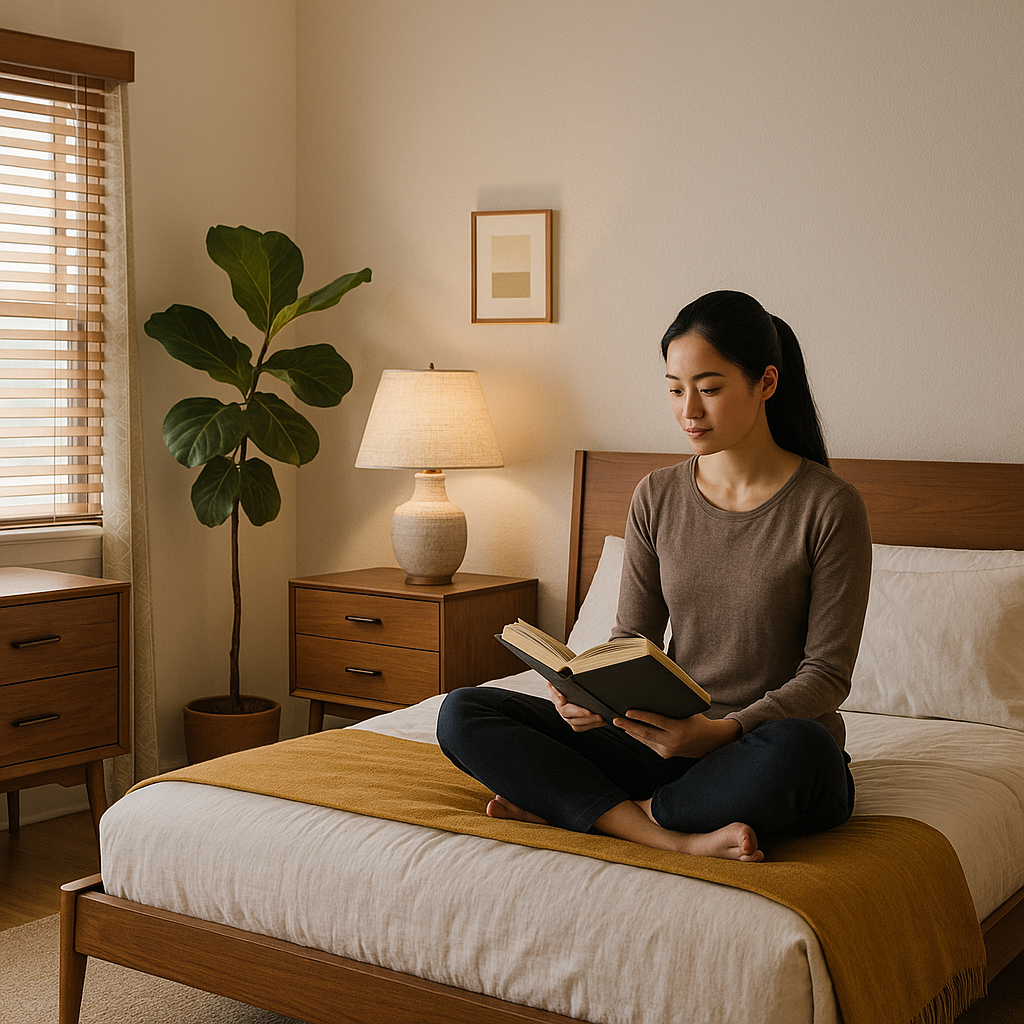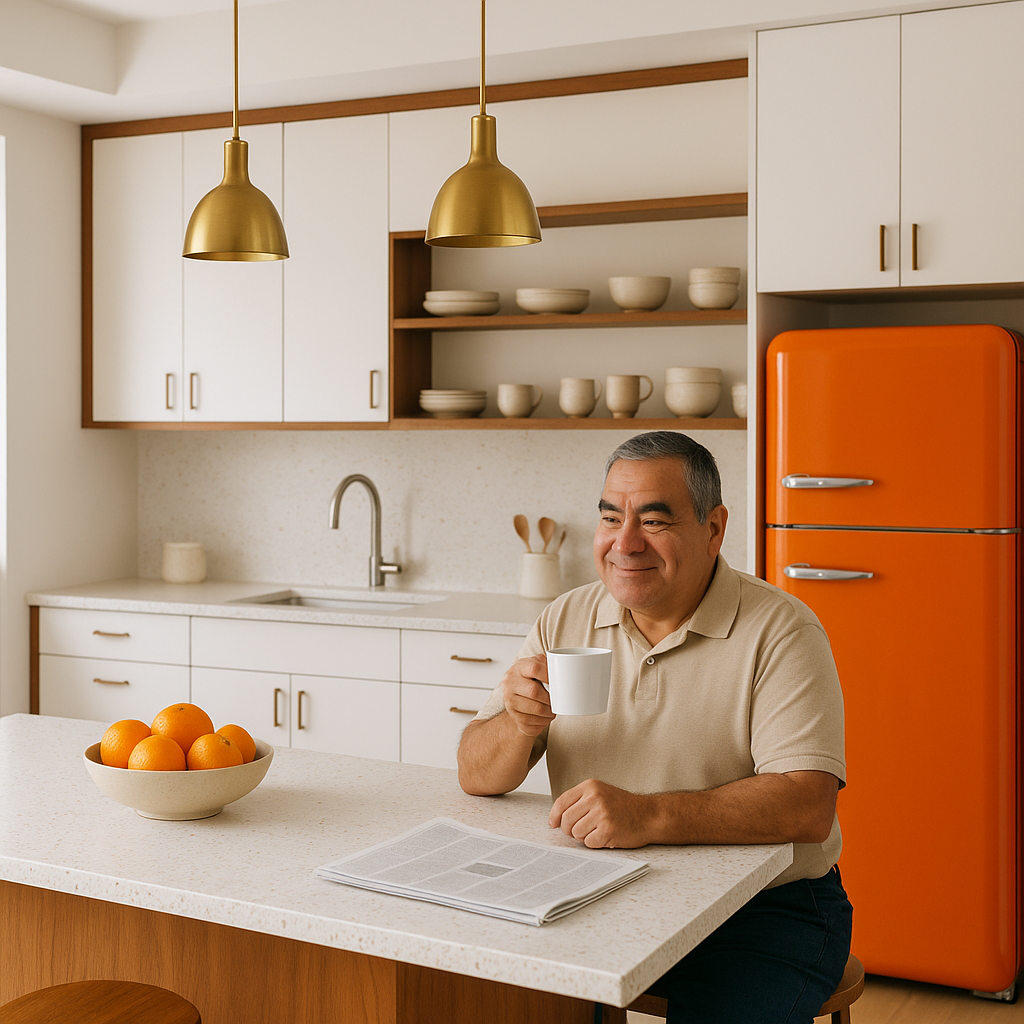Mid-Century Modern Decor: Tips for a Complete Look

Mid-Century Modern Decor: Tips for a Complete Look
Mid-century modern decor continues to captivate design enthusiasts with its timeless appeal, clean lines, and functional elegance. Born from the design revolution between the 1940s and 1960s, this distinctive aesthetic combines minimalist practicality with organic forms, creating spaces that feel both nostalgic and remarkably current. The beauty of mid-century style lies in its accessibility—whether you’re a dedicated collector of authentic vintage pieces or simply looking to introduce a few iconic elements into your existing decor.
In this comprehensive guide, we’ll explore how to achieve a complete mid-century modern look that feels authentic yet fresh. You’ll discover the fundamental principles that define this enduring style, essential furniture and accessory recommendations, room-by-room styling approaches, and practical tips for balancing vintage treasures with contemporary pieces. By the end, you’ll have the knowledge and inspiration to transform your space into a sophisticated mid-century sanctuary that remains uniquely yours. As you begin this design journey, remember that vintage aesthetics are having a major moment for good reason—they connect us to craftsmanship, history, and timeless design principles.
Understanding mid-century modern: origins, principles, & iconic features
The mid-century modern movement emerged during a period of tremendous cultural and technological optimism following World War II. As American suburbs expanded and lifestyles evolved, designers embraced new manufacturing techniques and materials to create furniture and architecture that prioritized function, accessibility, and a connection to nature. Influenced by earlier modernist movements and Scandinavian design principles, mid-century style rejected unnecessary ornamentation in favor of honest materials and organic forms.
What truly distinguishes this aesthetic is its enduring commitment to clean lines and minimal fuss without sacrificing warmth or comfort. The hallmark features include open, flowing spaces; large windows that invite nature indoors; a harmonious blend of natural and manufactured materials; gentle organic curves contrasted with geometric patterns; and a distinctive color palette that ranges from muted neutrals to vibrant accent hues.
The movement’s most influential designers became household names whose work continues to inspire. Charles and Ray Eames revolutionized furniture design with their innovative molded plywood and fiberglass chairs, while George Nelson’s platform benches and iconic bubble lamps exemplified the era’s innovative approach to everyday objects. Florence Knoll brought modernist principles to office spaces, and Eero Saarinen created the revolutionary Tulip collection that eliminated the “slum of legs” under traditional tables and chairs.
Why vintage & retro appeal endures
The resurgence of mid-century modern design isn’t merely a passing trend but represents a deeper appreciation for craftsmanship and intentional living. Modern homeowners are increasingly drawn to the humanistic qualities of these designs—their connection to natural materials, emphasis on functionality, and rejection of disposable consumption. The clean silhouettes and versatile forms of mid-century furniture allow these pieces to integrate seamlessly with contemporary interiors.
Additionally, the sustainability movement has fueled interest in authentic vintage pieces that have already proven their durability over decades. Rather than purchasing mass-produced items with short lifespans, many homeowners are discovering the environmental and aesthetic benefits of investing in well-crafted originals or thoughtfully designed reproductions. To complete the authentic ambiance, many enthusiasts find mid-century inspired wall art that complements their furniture while adding personality and visual interest.
Key elements of a mid-century modern home
Creating a cohesive mid-century modern space requires understanding and implementing several fundamental design elements. While individual pieces make a statement, the overall effect comes from how these elements work together to create harmony and balance. Let’s explore the essential components that define this beloved aesthetic.
Mastering the mid-century color palette
The distinctive color scheme of mid-century design bridges earthiness with optimism. Traditional color foundations include:
- Rich wood tones like walnut, teak, and oak that provide warmth and grounding
- Warm neutrals including ivory, cream, and taupe that create breathing space
- Muted earth tones such as olive green, ochre yellow, and burnt orange that reference nature
- Bold accent colors including teal, mustard, and coral that inject playfulness
To implement this palette effectively, consider the 60-30-10 rule: use neutral tones for 60% of your space (walls, larger furniture), wood tones for 30% (furniture, flooring), and vibrant accents for the remaining 10% (cushions, art, accessories). This approach prevents the space from feeling overwhelming while maintaining visual interest. For a contemporary twist, try incorporating black accents or matte finishes that update the look without compromising its authenticity.
Select furniture for authentic impact
Furniture forms the foundation of mid-century style, with several iconic pieces instantly recognizable for their distinctive silhouettes. When selecting key pieces, look for:
- Low-profile sofas with clean lines, tapered legs, and minimal tufting
- Shell-shaped chairs with slim, angled legs (like the iconic Eames molded chairs)
- Case goods with slim profiles, visible wood grain, and minimal hardware
- Round tulip tables or rectangular surfaces with hairpin legs
- Storage units with sliding doors, floating cabinets, or modular components
When shopping for these pieces, balance authenticity with practicality. While original vintage pieces offer unmatched character and quality, quality reproductions from reputable manufacturers can provide the right aesthetic at a more accessible price point. For those dedicated to authenticity, shop quality mid-century furniture from specialty retailers and vetted vintage dealers who can verify provenance and condition.
Lighting & accessories
Lighting serves as both functional necessity and sculptural art in mid-century spaces. Signature lighting styles include:
- Sputnik chandeliers with multiple arms radiating from a central core
- Globe pendant lights with simple, spherical forms
- Arc floor lamps that create dramatic overhead lighting without ceiling fixtures
- Table lamps with ceramic bases and textured or geometric shades
Accessories complete the look with purposeful details rather than cluttered collections. Consider incorporating:
- Sunburst or starburst wall clocks in wood or metal
- Abstract or geometric art with limited color palettes
- Ceramics with organic shapes or graphic patterns
- Textiles featuring atomic patterns, geometric motifs, or abstract designs
- Houseplants—especially sculptural varieties like fiddle leaf figs, rubber plants, or trailing pothos
For authentic styling, aim for intentional curation rather than overcrowding. Each accessory should earn its place through either function or aesthetic contribution, maintaining the movement’s commitment to purposeful design.
Designing room by room: living, dining, bedroom & beyond
Mid-century modern principles can be adapted to every room in your home, with each space offering unique opportunities to showcase different aspects of this versatile style. The key is maintaining visual coherence while addressing the specific functions of each area.
Living room
As the heart of mid-century social life, the living room embodies the style’s commitment to both comfort and conversation. Begin with a furniture arrangement that promotes interaction—floating furniture away from walls to create intimate conversation areas rather than focusing on a television. A characteristic layout might include:
- A streamlined sofa positioned perpendicular to a pair of lounge chairs
- A substantial coffee table with organic shape in wood or glass
- A credenza or sideboard along one wall for storage and display
- A statement floor lamp arching over the seating area
Incorporate a geometric area rug to define the space and add textural interest.
For walls, consider wood paneling for authentic period character or a neutral paint color that highlights your furniture’s clean lines. Complete the room with strategically placed art—abstract prints, atomic-inspired pieces, or landscape photography in slim frames will enhance the aesthetic without overwhelming the space.
Dining room
Mid-century dining spaces celebrate the ritual of gathering around good design. The dining table serves as both functional surface and sculptural centerpiece, so select one with distinctive character—whether a round tulip-base model or a rectangular table with tapered legs. Surround it with chairs that complement rather than match precisely; the eclectic collector approach feels more authentic than perfect symmetry.
Lighting plays a crucial role in dining areas—position a statement pendant or chandelier approximately 30 inches above the table surface. For storage and serving needs, incorporate a sideboard with sliding doors or a floating credenza that keeps the floor visible underneath, enhancing the sense of spaciousness. Dinnerware in solid colors or simple geometric patterns completes the sophisticated yet approachable dining experience.
Bedroom
Mid-century bedrooms balance simplicity with comfort, creating restful retreats that feel both cozy and uncluttered. Start with a low-profile bed frame—platform styles with integrated nightstands or headboards with subtle winged edges capture the era’s characteristic forms. Keep bedding relatively simple with solid colors or subtle patterns in natural fabrics like cotton and linen.
For storage, select dressers with tapered legs that elevate the piece off the floor, creating a lighter visual footprint despite substantial storage capacity. Incorporate asymmetrical bedside lighting with adjustable reading lamps or sculptural table lamps. Window treatments should prioritize both function and clean lines—wooden blinds or simple panel curtains in textured fabrics offer privacy without fussiness.
Kitchen & bath
Though often challenging to fully renovate, kitchens and bathrooms can incorporate mid-century elements through thoughtful updates. In kitchens, consider flat-front cabinetry with minimal hardware, countertops in terrazzo or laminate with boomerang patterns, and appliances in either retro colors or sleek stainless steel. Open shelving displays carefully curated collections of functional ceramics and glassware.
For bathrooms, emphasize clean lines with simple fixtures and strategic color. Hexagonal or penny tile in characteristic hues creates period-appropriate floors, while wood accents warm the typically cool surfaces. If a full renovation isn’t feasible, update with smaller elements like lighting, hardware, and accessories—a starburst mirror, brass fixtures, or colorful textiles can reference mid-century style without major construction.
When designing these functional spaces, avoid creating a “time capsule” effect by incorporating some contemporary elements. This retro vs vintage balance ensures spaces feel livable rather than museum-like.
Balancing old and new: tips for a fresh, personal take
The most compelling mid-century modern interiors avoid slavish reproduction in favor of thoughtful curation that honors the past while embracing the present. This balance creates spaces that feel both timeless and relevant, reflecting your personal journey rather than a designer’s template. The goal isn’t to recreate a 1950s home but to capture the era’s spirit of innovation and optimism in a contemporary context.
Start by identifying a few authentic anchor pieces—perhaps a vintage credenza, an iconic lounge chair, or a distinctive lighting fixture—that will establish the style’s foundation. Around these stars, incorporate contemporary basics that complement rather than compete with your statement pieces. This strategy not only makes the style more financially accessible but creates a more interesting narrative within your space.
Maintain coherence through a consistent material palette: warm woods, touches of brass or chrome, and natural textiles create continuity even when pieces come from different decades. Similarly, establish a defined color scheme that threads throughout your space, linking disparate elements through chromatic relationships rather than matching sets.
Add personal history through thoughtfully selected art and objects that tell your story. This might include family photographs in slim frames, travel souvenirs displayed with restraint, or contemporary artworks that resonate with mid-century aesthetics while reflecting current perspectives. Original art prints and retro posters can bridge different eras while adding personality to gallery walls or as standalone statement pieces.
Where to shop & what to avoid
Sourcing authentic mid-century pieces requires patience and research. Explore local options like estate sales, dedicated vintage shops, and consignment stores where you can examine pieces in person. For online shopping, established platforms like 1stDibs, Chairish, and even Etsy offer curated selections with detailed descriptions and provenance information. Specialized dealers often provide authentication and restoration services that ensure your investment pieces will last for generations.
For those mixing vintage with new, several contemporary manufacturers produce quality reproductions or pieces inspired by mid-century principles. Look for companies that acknowledge their inspirations rather than those claiming to sell “authentic” pieces at suspiciously low prices. Authentic reproductions will feature quality materials, proper proportions, and attention to construction details that honor the original designs.
When building your collection, avoid these common pitfalls:
- Poor-quality knockoffs with incorrect proportions or cheap materials that undermine the style’s emphasis on craftsmanship
- Over-coordinated “sets” that lack the collected-over-time quality of authentic interiors
- Excessive theming that turns your home into a mid-century museum rather than a livable space
- Ignoring comfort and practicality in favor of style—the original designers prioritized both
Remember that sustainable acquisition takes time. The joy of creating a mid-century inspired home lies in the gradual discovery of pieces that speak to you, rather than rushing to complete a look overnight. This patient approach honors both the style’s heritage and contemporary values of mindful consumption.
Conclusion
Mid-century modern decor endures not simply as a style but as a design philosophy that celebrates the marriage of form and function. Its continuing popularity speaks to our collective desire for spaces that feel both sophisticated and livable, distinctive yet timeless. The beauty of this aesthetic lies in its adaptability—while rooted in specific historical context, its principles transcend decades to remain remarkably relevant in contemporary homes.
As you develop your own interpretation of mid-century modern style, remember that authenticity comes not from perfect period recreation but from embracing the movement’s core values: honest materials, purposeful design, connection to nature, and optimistic innovation. By balancing vintage treasures with contemporary pieces, you create a home that honors design history while remaining deeply personal and present.
Whether you’re adding a single iconic chair to your existing decor or embarking on a comprehensive mid-century transformation, approach the process with intentionality and patience. Seek pieces that bring both beauty and utility to your daily life, and allow your space to evolve organically as you discover items that resonate with your personal aesthetic. With thoughtful curation and respect for fundamental principles, your mid-century modern home will offer enduring pleasure and inspiration for years to come.
Frequently asked questions
What defines mid-century modern decor?
It’s a style from the mid-20th century featuring clean lines, functional forms, organic and geometric shapes, and a blend of wood, metal, and cheerful color accents.
How do I mix vintage and new pieces without making my space look dated?
Stick to a defined color/material palette, combine iconic vintage finds with contemporary basics, and anchor with a few standout pieces instead of going overboard.
What colors work best for a mid-century modern interior?
Mustard yellow, teal, olive, burnt orange, walnut and honey-toned woods, plus plenty of neutral whites and greys. Brighter pops work well in art or textiles.
Where can I shop for affordable mid-century modern furniture?
Look for vintage markets, thrift shops, online platforms like eBay and Etsy, and vintage-focused retailers. Some brands offer quality reproductions at various price points.
What’s the difference between ‘retro’ and ‘vintage’ decor?
Retro refers to newly made items styled to look like those from the past, while vintage means authentic items from the era itself. See more on retro vs. vintage differences.